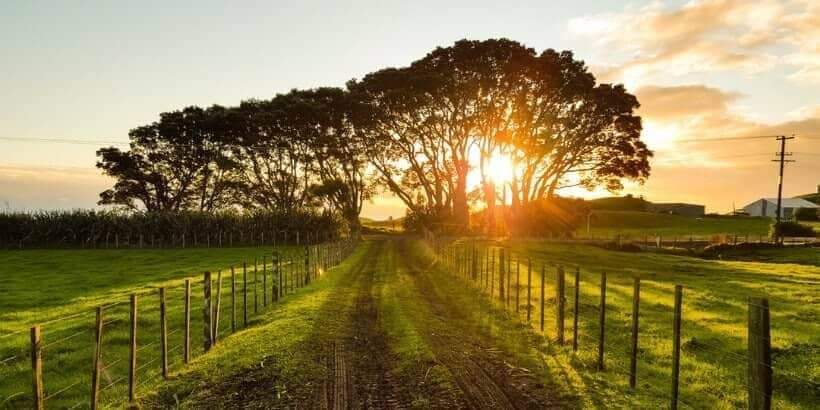A Call for Regenerative Agriculture: From the Group Up

Farmland covers 38 percent of the Earth’s land area and is a major contributor to climate change. But it doesn’t have to be this way. Soil and plants have the capacity to store huge amounts of carbon in the ground, thus how we grow food can be one of the key solutions to our climate crisis.
Visionary farmer and educator Charles Massy argues that an ecologically and socially enhancing agriculture—known as regenerative agriculture—can reverse these harmful carbon emissions by working with nature rather than against it to increase biodiversity, enrich soils, improve watersheds, and strengthen ecosystems.
The following excerpt is from Call of the Reed Warbler by Charles Massy. It has been adapted for the web.
Our species is labelled Homo sapiens sapiens – allegedly for being doubly wise. To the contrary, we have for many centuries behaved in a self-destructive manner. Initially, this behaviour was unwitting, but today it is not.
There is abundant evidence now that modern industrial agriculture and humanity’s ongoing burning of stored fossil fuels is destroying Earth’s life-sustaining systems, poisoning the foods we live on and divorcing us from a natural world we coevolved with.
While consuming more resources than Earth’s systems can replenish, we are hurtling towards multiple calamities. We must urgently and dramatically address the root causes of these impending disasters.
My book, Call of the Reed Warbler: A New Agriculture, A New Earth, is full of stories that show us how.
A widespread consensus is building among scientists that the Earth has moved out of the favourable Holocene period1 and into a new, human-shaped geological epoch: the Anthropocene.
Thus, for the first time, one species – humanity – is influencing (and may well determine) the future health and survival of life systems on this planet.2
What has precipitated the Anthropocene is that humanity has shifted from an organic, ever-renewing economy to one that is overwhelmingly extractive.
This is because, as the late, brilliant Jesuit ecological thinker Thomas Berry pointed out, we now continue to ‘see ourselves as a transcendent mode of being.
We don’t really belong here anymore.’3

Around 150 years of continuous grazing and burning prior to new owners in 2006 led to compaction, bare ground and erosion (and loss of profitability) at the Pearce family’s 4000-hectare subtropical ‘Bannockburn’ cattle station near Rockhampton, Queensland. This ‘before’ photo was taken during the dry season (August 2006) before the owners began holistic and cell grazing management under the Resource Consulting Service’s guidance.
Earth scientists such as Johan Rockström and Will Steffen have proposed a framework of nine ‘planetary boundaries’ within which humanity can safely operate.
Already three if not four of these boundaries appear to have been crossed: climate change, rate of biodiversity loss and the distortion of key biogeochemical markers (namely the interconnected global nitrogen and phosphorus cycles).
Of the remaining boundaries, we are rapidly approaching (or about to cross) a further three: ocean acidification, global fresh water use and changes to land cover and its systems by conversion to cropland and other uses.4
As historian John McNeill put it, ‘humankind has begun to play dice with the planet, without knowing all the rules of the game’.5
The expansion of industrial agriculture since 1950 is seen as a major contributor to this predicament. Thus agriculture is clearly vital in any attempts at addressing the imminent challenge to planetary survival.
If we are to preserve our living systems, then new and transformative responses will be required.
Much else is at stake – not least human physical and mental health. The current regenerative agriculture practices and thinking described in my book are all about life-saving transformation, and transformation not just in practice but also within the minds and hearts of individuals: farmers, consumers and decision-makers.6
Agriculture, in occupying thirty-eight percent of the Earth’s terrestrial surface, is both the largest user of land on the planet and humankind’s largest engineered ecosystem.
Because it is based on plants, which take carbon out of the atmosphere to make and store sugar through photosynthesis, and because these plants have roots growing in the ground, a healthy agriculture has the potential to bury huge amounts of carbon for long periods.
Excessive carbon dioxide in the atmosphere (largely due to the release of long-stored carbon through burning fossil fuels) is, we now know, one of the key causes of the greenhouse effect.
Absorption of excess carbon dioxide also makes the world’s oceans more acidic.
Moreover, when a healthy agriculture puts more long-lasting carbon into the soil while minimising the loss of such carbon, this in turn has a major impact on the water cycle and its crucial role in thermoregulation (i.e. climate control) of our planet.
But the problem is that traditional industrial agriculture – through practices such as burning vegetation for land clearing, using fossil fuels (in fertilisers and chemicals, and to power farm machinery), overgrazing, ploughing and fallowing – emits, rather than stores, carbon.
But it need not be this way.
An ecologically and socially enhancing agriculture – what I call ‘regenerative agriculture’ – can reverse this harmful carbon-emitting signature of industrial agriculture.
It can do this via various methods, but all are based around revegetation and inculcating healthy, living soils (that is, soil containing plants, insects, bacteria, fungi and other organisms).
The practice of regenerative agriculture across vast swathes of the world’s farmlands, grasslands, marginal savannahs and arid regions can provide a major solution to climate change as well as confronting the other key Anthropocene planetary boundary challenges.
However, the trashing of landscapes and life-supporting systems is not the only negative impact of modern industrial agriculture.
Another is the way it produces food and then how it processes, distributes, markets and sells it. At the same time as we are degrading the air we breathe, we are also denaturing the food we eat and water we drink and lacing them with a witch’s brew of deadly poisons.
So the confronting truth is that much of the modern threats to human health, including the near exponential increase in modern chronic diseases, is due to our industrial systems and especially those embedded in industrial agriculture.

Bruce Maynard’s son Liam. Bruce writes: ‘This picture is of an Australian boy aged sixteen who planted, grew and harvested this crop without harming the ecology, using no fertilizers or chemical sprays of any kind, and with a tenth of the fuel use of conventional methods.’
What is alarming about this modern health disaster is that four of its major causative or exacerbating factors are not on the public or political radar.
The first two relate to the fact that our bodies largely coevolved with our environment when we were hunter-gatherers.
Consequently, we are programmed to lay down fat in our bodies so as to survive lean times. Modern industrial diets and lifestyles mean we maladaptively keep putting on fat (especially chronic, disease-causing internal fat).
The second factor is that we also became adapted to eat a widely varied hunter-gatherer diet (and one packed with hundreds of different nutrients). In modern industrial society, we are only fed a minuscule number of these crucial nutrients.
When the decline in nutritional value of modern-day foods is added to this, the health consequences are awful.
The third causative factor in our modern health crisis is that the world’s most widely used agrochemical – glyphosate – is penetrating modern foods.
It is now being implicated as a primary causal factor in many of today’s major diseases. Finally, there is the effect of epigenetics, the newly apprehended but little-known ways in which genetic mechanisms are switched on or off by the surrounding environment.
All four factors are essentially invisible until they create damage, and when they do, the effects of the first three are amplified by the fourth, especially in future generations.
What makes this quartet of factors so deadly is that we are genetically hard-wired to live off our natural environment.
This includes eating food that is free of man-made chemicals. However, while we can’t change this genetic wiring, we can change our landscapes, and thus the food and water that they supply.
By shifting away from modern, chemically based industrial agriculture to one that regenerates Mother Earth and its systems, we address the Anthropocene boundary crossings at the same time.
Notes:
- Holocene: that unique period of post ice-age climatic conditions over the last 10,000 years or so during which agriculture evolved and humanity began its march towards modern civilisation.
- Rockström et al., p. 32.
- T. Berry, The Great Work, p. 104.
- This new macro approach to Earth’s life-support systems is timely because it enables the issue of global sustainability to be seen in the context of disruptions to the equilibrium of the self-organising system and self-regulating capacity of the planet.
- McNeill, p. 3.
- Rockström et al., p. 2; Foley et al., ‘Solutions for a Cultivated Planet’, Nature, p. 338.
Recent Articles
Beavers are ecological and hydrological Swiss Army knives. Capable of tackling just about any landscape-scale problem you might confront.
Read MoreAside from the sheer pleasure of telling your friends, straight-faced, that you maintain your garden using something called a “chicken tractor,” there are a slew of other benefits to working the land with a few of your animal friends. Getting rid of pests without chemicals, for one; letting them do the work of weeding and…
Read MoreIf the idea of running a vegetable farm sounds daunting, you’re not alone. What can you do to simplify techniques and reduce expenses? Where do you even begin?
Read MoreWhen you’re walking around the grocery store looking at the vegetables, it’s probably hard to imagine that a century ago there was twice the amount of options.
Read MoreIf you love tomatoes, you probably already know just how many varieties of these summertime staples there are. But do you know what makes each one unique?
Read More








